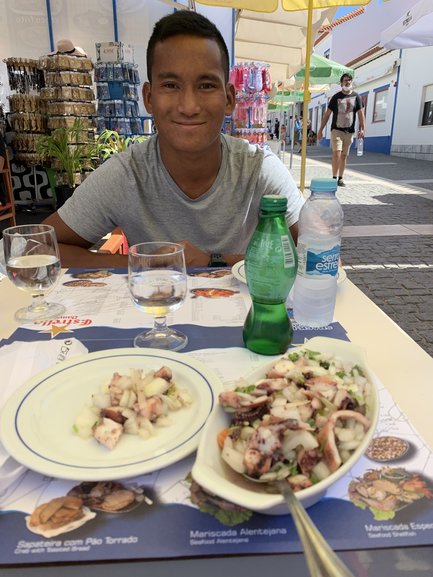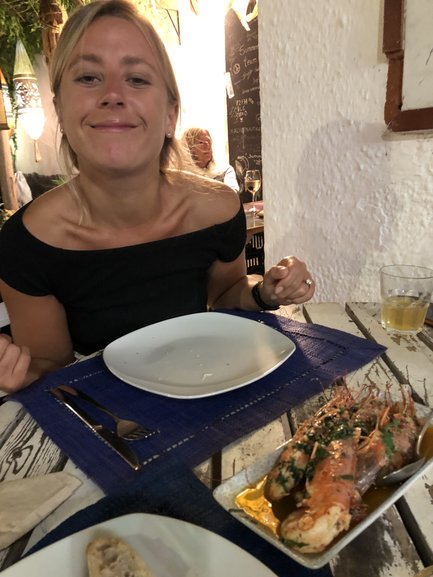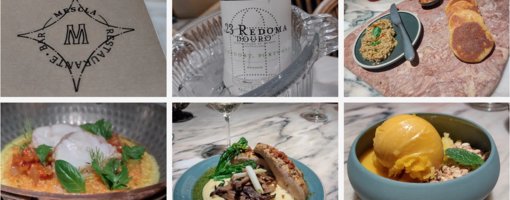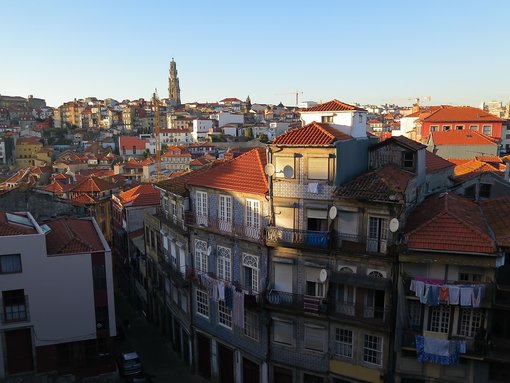It's time to write about our favourite topic again… FOOD!
If we aren't eating, we are thinking about eating, planning our next meal or researching a new restaurant to try. As much as we love to eat out and try new restaurants we also both love cooking and get excited about cooking new recipes, shopping for local ingredients and creating great meals.
Portuguese Food
Since arriving into Portugal in August we have been based in two areas, Lisbon and then Western Algarve (Alvor & Lagos). Portugal may not be considered a huge country but they have plenty of national traditional dishes. As well as these national dishes in different regions of the country you find varying popular local cuisines too.
You'll find many regional Portuguese dishes across the country, emphasizing fish, meat, olive oil, bread, tomato, herbs, and spices.
The food in Portugal is made with simple ingredients that are always fresh, flavoursome and well prepared. Best paired with a bottle of Portuguese wine, as there is a vast choice to choose from and Portugal has many great wine producing regions. Portuguese wine definitely doesn't get enough credit in our opinion! They are mostly well priced and a great accompaniment for the Portuguese food.
While we were in the centre of the country for example in the area of Fundão we noticed large amounts of pork dishes being served whereas down here in the Algarve fresh fish is very common. There are dishes like a Bifana (a pork steak sandwich) that are easily found all over the country. Then dishes like Pica-Pau which was historically and traditionally a dish with wood pigeon which is now sometimes adapted to a more modern offering of beef.
An ingredient easily found and well used across the country is Bacalhau which is dried and salted cod. If you go near the fish section in any Portuguese supermarket you will be sure to get a whiff of this! There is a huge range of recipes using Bacalhau, making it extremely popular with the Portuguese population.
Now we by no means have tried all the traditional Portuguêse dishes on offer but we have some firm favourites that we think are worth a go. Here they are:
Clams ‘Bulhão Pato' Style
– These clams (Amêijoas in Portuguese) in a garlicky broth were named after Bulhão Pato, a 19th-century Portuguese poet. Popular throughout the country it's often served as the first course of an elegant meal or as the main course of a light lunch. Think of it as the Portuguese version of Moules Marinière. The Algarve, the southernmost region of Portugal, enjoys a great reputation for the variety and freshness of its fish, shellfish and crustaceans. This is the region that a large portion of the seafood consumed in Portugal originates, including clams. Some are farmed and others are picked up by mariscadores, shellfish farmers. We have been lucky enough to have experience lots of great versions of this dish in Lisbon and The Algarve.
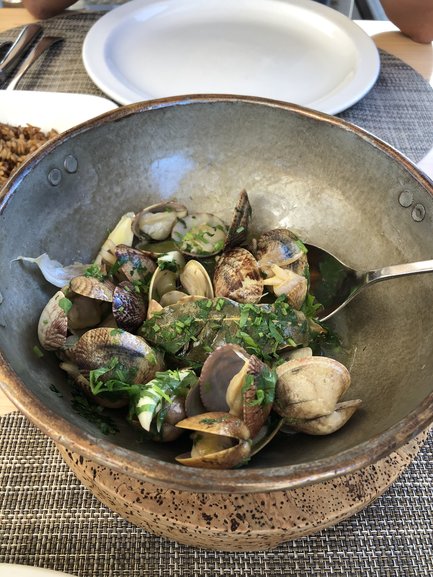
Some of our favourite Clams ‘Bulhao Pato' – Adega de Marina, Lagos, Restaurante Zanzibar, Lisbon, Atascado, Alvor, 2 Passos Almancil, Restinga, Alvor and Casa Alys & Nathan, Lagos.
Bitoque
– This is a traditional Portuguese dish which is more for the meat lovers. It consists of a lean fried or grilled steak or pork, usually accompanied by chips (fries for you odd folks), rice, various salads and topped with an egg. This recipe has its origin in Beira's, Portugal. Bitoque (pronounced bee-talk) is a reliable go to dish which has the bonus of being easy to make. Portuguese steak is a preparation of a fairly thin cut of meat, most commonly fillet of rump steak. We found this dish more popular in the Lisbon area and often was the ‘Prato do dia' in restaurants, which usually meant you could eat a soup starter, a Bitoque main, a dessert, coffee and small beer for something in the region of €10.
Piri Piri Chicken
– Is it Piri Piri Chicken or Chicken Piri Piri? I have no idea but it's delicious. Known as frango assado in Portugal, piri piri chicken is an Algarvian culinary specialty. It involves spatchcocking a chicken, throwing it on a hot grill, and brushing it with piri piri sauce. Different versions of the sauce have been kicking around since the 15th century after Portuguese colonists first stumbled upon the chilli pepper while voyaging overseas. This small spicy chili pepper was known as Piri-Piri, Peri-Peri, or ‘African devil'. By blending this chilli with ingredients such as garlic, vinegar, olive oil, salt, bay leaves, lemon juice, piri piri sauce was created. We have found our favourite experiences of this dish to be in Churrasqueira Restaurants. A Churrasqueiro is somebody who cooks churrasco style food in a churrascaria restaurant or at home. A churrasqueira is a barbecue grill used for this style of cooking and usually these restaurants specialise in this style of grilled chicken.
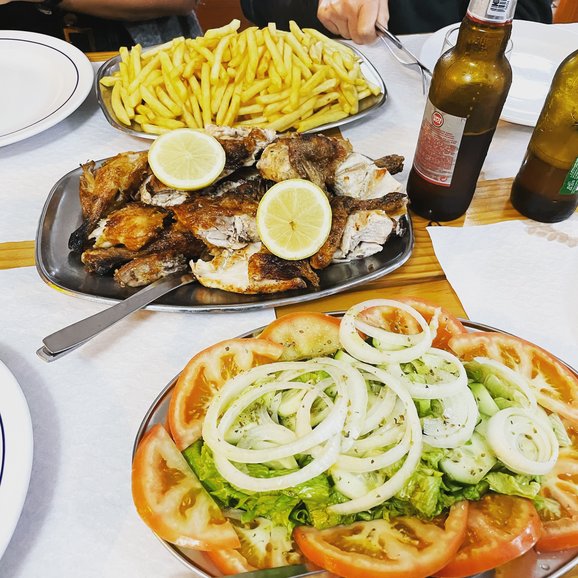
Our favourite Churrasqueira experiences – Churrasqueira Praça D'Armsas, Lagos and Churrasqueira Mercado de Alvôr, Alvor.
Bifana
– A Bifana is considered the national sandwich of Portugal. Bifanas are traditional Portuguese pork sandwiches, so popular that you'll find them everywhere in the country. These Portuguese sandwiches are made of a thinly sliced piece of marinated pork served in crunchy white bread. The marinade is made with spices including paprika, garlic, and white wine. The bread has a crunchy crust on the outside while being soft on the inside. The original Bifana Portugal recipe is said to come from Vendas Novas, a small town in the Alentejo region, mid-distance between Lisbon and Evora. Sometimes it's served with chips (fries) as a meal. However we rather it served with beer as a late night Portuguese snack.
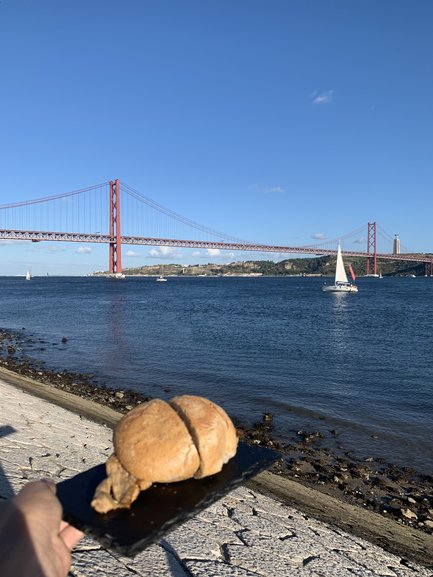
Bifana overlooking Ponte 24 de Abril, Lisbon and at Loja da Praça, Lagos
Charcoal Grilled Fish
– This is a bit more of a vague one but you can't talk about Portuguese food without mentioning the amazing grilled fish. The best and freshest grilled fish we have ever eaten has been on the Portuguese south coast. There are too many types of fish to mention but some of the most popular include white fish such as sea bass, golden bream and lemon sole. You can also get wonderful grilled sardines, salmon and tuna. Usually caught that very day, the fish is then displayed in fridge cabinets in the restaurants. On enquiring about fresh fish the waiters will often present you the fishes you like and inform you of their weight and how many people it will feed. It's great being able to see the fish raw first as you can really see how fresh it is! Then the fish is normally grilled on big charcoal BBQs often in an open kitchen at the front of the restaurant. You can then really enjoy the amazing smells of the process. The fish is then brought to your table and filleted at you table by the waiters who make it look so easy and like an actual art form. The fish is always flakey, meaty and delicious. You can usually have it with boiled potato's or chips (fries) and salad or vegetables. Simple sides for what is the main event. We are always fans of fish dishes with lovely sauces and sides however you really can't beat the simplicity of the Portuguese grilled fish.
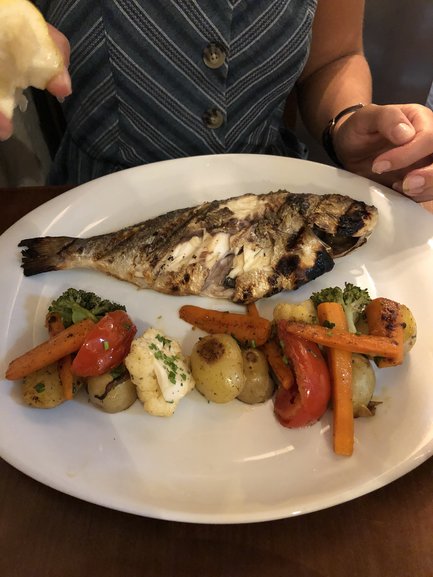
Some of our favourite fish meals – Adega de Marina, Lagos, Bj's Oceanside, Loulé, El Rei D'Frango, Lisbon, Mania do Peixe, Sesimbra, Casa Alys & Nathan, Lagos
If you are visiting Portugal keep your eyes peeled for these dishes on the menu, they aren't to be missed!
Até breve!
